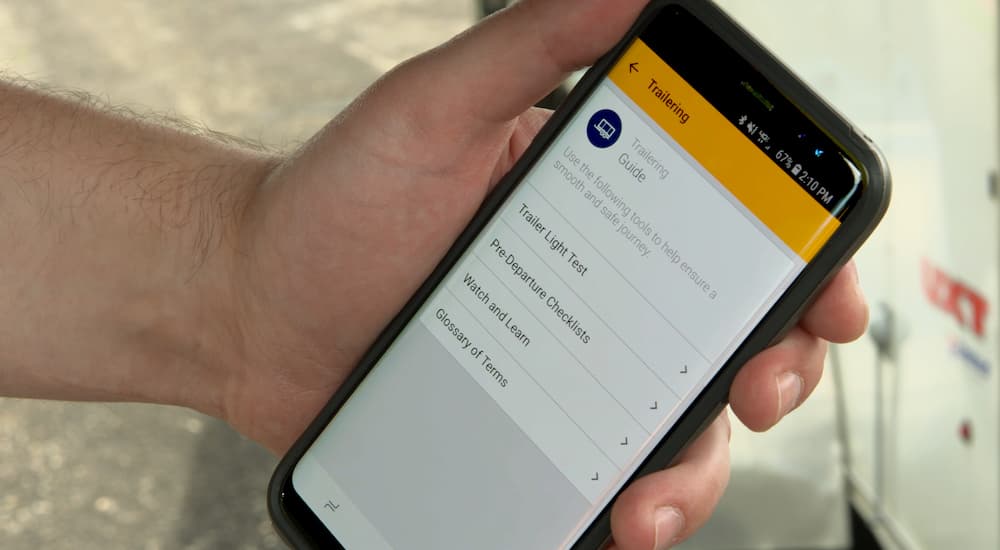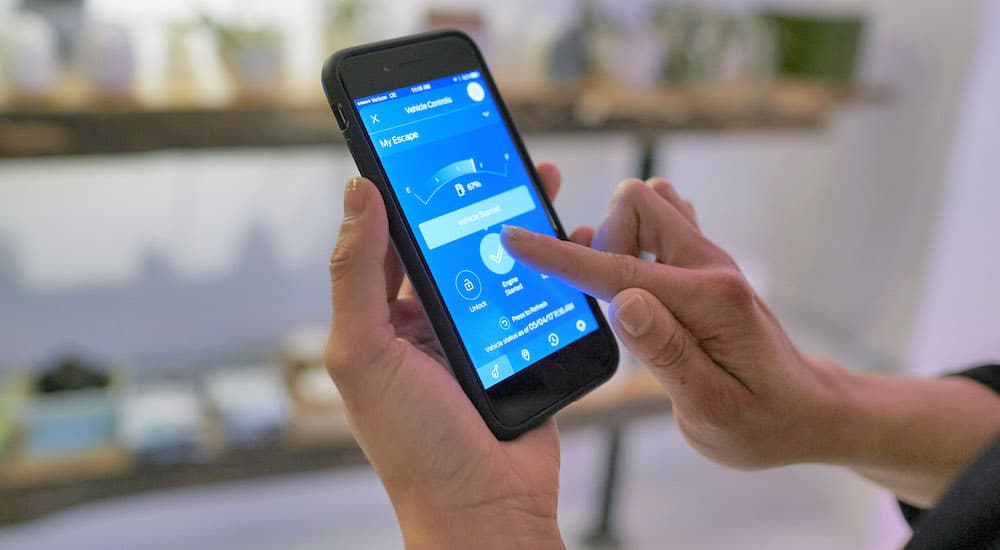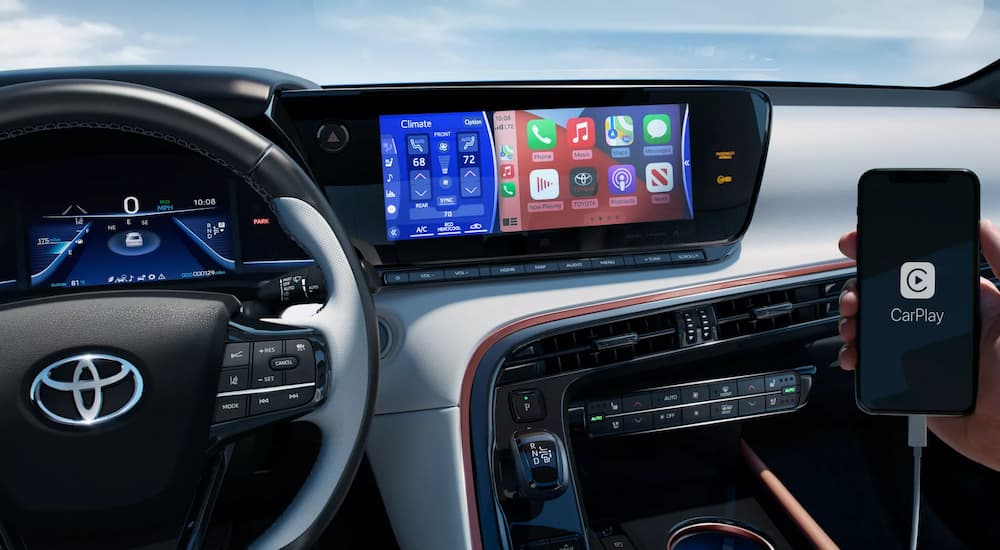Whether you’ve been browsing brick-and-mortar dealerships or searching online car sales, you may have noticed that a lot of newer vehicles have features that work by connecting the car directly to your smartphone. While each automaker has its own app, a lot of them offer the same basic features. So let’s take a look at what connecting your car to your phone can do.
Before we dig in, we want to clarify that we’ll mostly be discussing features and apps in general terms. There is a wide range of options out there, from HondaLink to MyChevy, and each one is different. Since there are a lot of things that they have in common, it’s easiest to talk about them generally instead of getting bogged down in the details. However, if you’re buying a car, you should always check the specifics for the particular model you’re looking at.
One thing that almost all of these apps have in common is that not all features are available for everyone. For one thing, you have to make sure that your vehicle is compatible. Sometimes, only certain model years or trim levels are eligible. Once you’ve picked the right vehicle, be aware that you’ll probably need to pay for a subscription in order to access at least some features. Again, this differs from brand to brand, but in order to know what package is right for you, you first need to understand what the different features are and how you can make good use of them.
Digital Owner’s Manual
One common feature is a digital version of the owner’s manual. Not only does this come in handy if you’ve misplaced the physical copy, but it also has some unique advantages. For one thing, digital copies tend to be searchable, so you don’t have to flip through page by page to find the instructions you were looking for. They can also be updated if any errors are caught or if new software features become available for your car.
Remote Control
Yes, technology is at a point where you can use your phone to remotely control your car. Remote start lets you power up the engine before you get to your car. This can come in handy on days when it’s extremely hot or cold since you can have your car cooling down or heating up before you get in. Remote lock and unlock are pretty simple; you can use your phone to make sure you’ve locked your car or to unlock it from afar. While the system depends on having a good Internet connection to work, its range isn’t limited by distance like a key fob.
Security Features
There are plenty of different features that are designed to keep you and your vehicle safe and secure. Some apps send you a notification when your car alarm is triggered to let you know about a potential theft early so you can be proactive. If your car does get stolen, you can use a locator system to help the authorities track its location. The “find my vehicle” feature can also come in handy in other situations, like if you’ve simply forgotten where you parked. Remote reset lets you wipe your audio and navigation systems to the factory default settings, so thieves won’t be able to access any personal information that might be stored in your car.
Another thing that threatens your safety on the road is poor driving habits. Features like Driver Feedback can analyze how safe you drive, give you a score, and let you know how you can improve. There are also features that are designed to help parents of teen drivers set boundaries and keep tabs on their children. You can set limits like geofences, curfews, and speed alerts to get notified when your young driver steps out of line.
Real-Time Diagnostics
With vehicle notifications, any warning lights or maintenance minders that show up on your car’s interface are sent to your phone as well. You can also check things like fuel and oil levels in the app. And with recall notifications, you’ll know right away if any recalls come up that affect your vehicle.
If you get a notification that you need to bring your car in for maintenance, most apps let you schedule a service appointment with your local dealership. Any relevant diagnostic info will be forwarded as well, so you don’t have to explain the issue from scratch when you show up. With secure payments, you can even settle the bill right from your phone.
Another useful service you can connect with is roadside assistance. How this works varies depending on the automaker. Some provide a phone number or have a convenient SOS button in the app. Others have automatic emergency assistance, which kicks in when the system senses a collision and sends help your way.
Control Extra Features
Most of the features we’ve discussed so far apply to a wide range of vehicles. But some features are only available on certain models or on particular trim levels. A lot of these high-tech features can also be accessed and controlled remotely using the same apps.
If you have an in-vehicle navigation system, you can search for a destination on your phone and then wirelessly sync it to your vehicle’s interface. If you have an onboard Wi-Fi hotspot, you can review your data usage via the app. You can also change settings like the network name and password. With electric vehicles, you can monitor your car’s battery level while it charges or even schedule it to charge during particular hours while it’s plugged in at home. Plus, some apps let you search for nearby charging stations while on the go.
Some trucks and SUVs have technology that helps you stay in control while towing a trailer, and these features are often enhanced by the automaker’s app. For one thing, they can be a good source of information, like pre-trip checklists to review before you head out on a trip or a glossary that can help you stay up-to-date on the latest terminology. With a trailer load calculator, you can determine the total weight of everything in your vehicle and trailer so that you can tow with confidence.
A trailer light test lets you make sure all your trailer lights are in good working order before you hit the road. Zone lighting control lets you turn perimeter lighting on and off from your phone, so you can see what you’re doing when hitching up a trailer in the dark. There are also alerts that can warn you about potential trailer theft in real-time by sending you a notification if the wiring harness gets disconnected.
As automakers come out with unique tech-based features for their vehicles, they also discover new possible uses for their connected apps. For example, some of Ford’s new trucks, particularly hybrid and EV models, have an onboard generator built in. The FordPass App can be used to track the generator’s energy consumption and power modes. As automotive technology continues to evolve, we can expect smartphone apps to evolve alongside it.
Link the App to Other Devices
We’ve been focusing on using your smartphone to access these features, but some systems go further and let you hook other devices up to your account. For instance, you can use smart speakers like Amazon Alexa or Google Home to give voice commands. Or, if you have a compatible smartwatch, you can use that to access remote services as well.
Technology Just Keeps Evolving
Looking over all of the features these apps offer, it’s easy to see why they have become more widespread in recent years. From high-tech security to remote control, there are plenty of things that you can do by connecting your car to your phone. Of course, how useful this is depends a lot on how tech-savvy you are and how good of an Internet connection you can expect to get in the places you live and drive. But even if it’s not for everyone, this new tech seems to have some real utility, and we’ll be interested to see how it grows and changes over the next few years.





